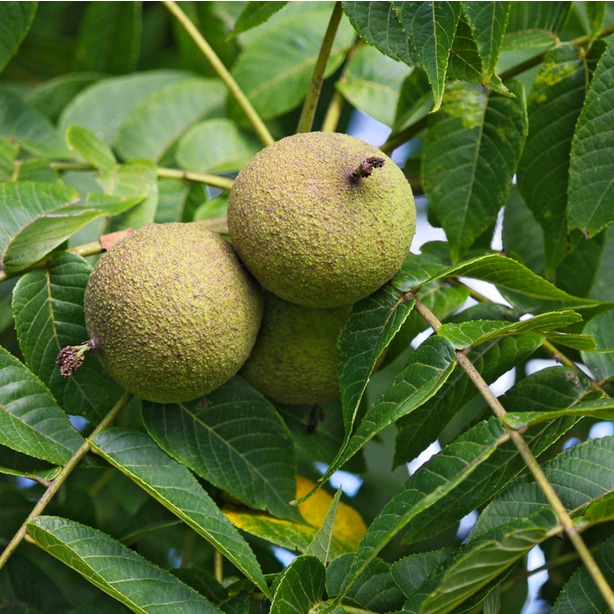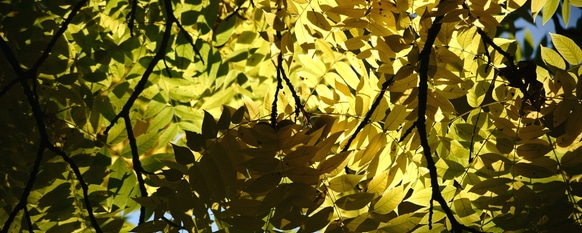This is a tree with a rich history in North America. Its wood has a deep, lustrous, and elegant color that is dimensionally stable and not prone to splitting as it dries. Therefore, it is a prized hardwood.
The wood was preferred for making cabinets, furniture, and gunstock, so by the 1960s, few of this species were still around. Efforts were made to restore these magnificent trees, but progress has been slow. It takes 12 to 15 years before the tree produces any nuts and 40 to 60 years of constant care for it to fully mature.
But don’t let these numbers scare you off. Your hard work in caring for this woody plant will pay off as it matures into a majestic addition to your yard. Here, you will find a complete guide for planting and caring for one of the most illustrious trees of North America.

General Information
The black walnut (Juglans nigra) is formally known as the eastern black walnut. It is a species of deciduous tree in the Juglandaceae, or walnut, family. It is native to a wide area of North America that extends from southern Ontario to southeast South Dakota and central Texas.
Black walnut trees have a distinctively spicy odor that emanates from most parts of the tree. Its growth habit differs between trees grown in open areas and those grown in forests. Specimens growing in woodlands that face competition for sunlight grow a tall, straight trunk that reaches heights between 100 and 130 feet. Those grown in open areas will have a shorter trunk with a broader crown. The tree has a yearly growth rate between 12 and 24 inches.
The large, dark green leaves grow alternately on the stem to a length of 1 to 2 feet. Each stem has 15 to 23 leaflets, including a terminal leaflet on each stem. The leaflets are largest towards the center of the stem. In that location, they grow to be between 2 and 4 inches long and ½ to 2 ½ inches wide. The leaflets have a serrated edge and grow from a rounded base out to a pointed tip.
Walnuts, the fruit of the tree, ripen during the summer and autumn into a spherical nut with a greenish-brown, flesh-like husk encompassing a corrugated brown nut. Mature nuts will fall to the ground around October and produce relatively small seeds.

This particular species has a massive taproot that grows deep into the soil. The roots also spread out broadly. When planting saplings in an area, they will require spacing. The taproot will make it difficult to transplant the tree once it has grown beyond the size of a sapling, so keep this in mind before you plant.
One key feature of the root system is that it is allelopathic. This means that it secretes the chemical juglone into the soil, which is toxic to certain plants’ species. Some of the juglone-susceptible plants include tomatoes, potatoes, peas, peppers, cabbage, apples, blueberries, blackberries, azaleas, and rhododendron.
So, before you plant new trees or plant others close to them, do your research to make sure all the plants get along.
Care Guide
Here is what you need to be aware of when caring for your new black walnut trees.
Sun Requirements
Juglans nigra is a tree that demands sunlight for proper growth. It requires at least 6 hours of direct, unfiltered sunlight every day. Avoid locations where frost collects, and choose a planting site that is sheltered from the wind. A tall tree like this one is susceptible to being snapped by high winds.

Soil Requirements
This species requires deep soil first and foremost. Its massive taproot requires soil unburdened by bedrock or other impermeable features for at least 5 feet. You must perform a test with a special soil penetrating tool to ensure that the roots will have enough room.
Aside from the prescribed depth, black walnut grows best in sandy loam soil that is well-drained and rich in nutrients. It tolerates a wide range of pH levels, from 5.0 to 8.0. For optimal growth, the tree prefers slightly acidic soil ranging from 6.0 to 6.5. It’s worth mentioning that the tree is sensitive to elevated levels of sodium, chlorine, and boron.
This species does not fare well in areas surrounded by hills, as they are prone to frost and tend not to drain easily. Stagnant water can be a death sentence for most root systems, and the black walnut is no different.
The young roots of newly planted saplings are very sensitive. Before planting, you’ll have to plow to a depth between 20 and 30 inches to remove any perennial weed roots that might compete for nutrients and to fluff up the soil. Perform a soil test to determine not only the pH level but also the nutrient content. If it is low, you must add organic matter, like compost or manure, before planting.
Water Requirements
With this woody plant, watering is an involved task, as it does not do well during dry periods. There are two rules of thumb that you’ll need to keep in mind to support healthy growth.
The first rule of thumb is that it needs 50 inches of irrigation through the course of one year. If you calculate that this comes to about 1 inch of water a week, be aware of the second rule.
That rule states that it should receive 50% of the annual irrigation requirement during the summer months (June, July, and August). That means that for those 12 weeks, your plant will require a little above 2 inches of water per week.
This might sound complicated, but remember that outside of the summer months, your walnut grove will only need about 25 inches of water spread out over 40 weeks. Natural irrigation should take care of this. If you need to supplement with your garden hose, water the soil outward from the trunk to the drip edge of the canopy. Ideally, water to a depth of 3 to 6 feet.

Fertilizer
Black walnut will benefit from two applications of very different fertilizers through the course of the year.
In early spring, give the plant a nitrogen boost with an application of ammonium sulfate. Ammonium sulfate generally comes with an NPK ratio of 21-0-0. Apply 9 pounds of ammonium sulfate per 1,000 square feet. Divide those numbers accordingly if you do not have 1,000 square feet of trees to cover. For example, if you only have 100 square feet of area to cover, apply 14.5 ounces of ammonium sulfate. Do not spread the ammonium sulfate up to the trunk. Use a mark 1 ½ feet from the base of your black walnut as your starting point.
The second round of black walnut fertilization takes place during the summer. Using a well-balanced fertilizer with an NPK ratio of 15-15-15, provide every tree with 4 ounces of product. As with the ammonium sulfate, spread the fertilizer evenly from the drip edge to 1 ½ foot from the base of the trunk.
As always, don’t forget to water the fertilizer into the soil. You want the fertilizer to reach the roots below the ground.
Growing Tips
Here are some pointers for you to keep in mind to ensure that your black walnuts are around for future generations.

Propagation
If you’re planning on planting black walnuts, it’s best if you buy a young tree or purchase a seedling that has already been germinated. The roots of black walnuts are sensitive and fragile while they’re young. And sprouting from seed is not always easy.
However, if you do wish to plant your seeds, follow these steps:
- Gather the nuts and remove the husks.
- Gather six nuts that have been dehusked to plant.
- Plant them 4 inches apart in a cluster 4 to 5 inches deep in the soil.
- Cover the planting area with a cloth and pin it to the ground to prevent wildlife from digging the nuts up.
- Place a layer of mulch, straw, or leaves over the planting site.
- Mark the site clearly.
The seeds will germinate in the spring, so remove the cloth in late winter. Once the trees have grown for a few months, select the healthiest specimens and discard the weaker ones, so that they don’t compete for nutrients. Keep the soil moist until the seedlings are sturdy.
Potential Problems
Thousand Canker Disease
This is a disease that will produce cankers in the bark of black walnuts. It is the result of the combined activity of the walnut twig beetle and the canker-producing fungus Geosmithia morbida. The walnut twig beetle pierces the bark and leaves an open wound. The fungus then infiltrates the open wound and causes the cankers to form in the bark.
The disease can be lethal within a few years. Use the appropriate insecticide and fungicide to treat the problem. Take care to choose products that will not affect the tree negatively.
Sunburn
Black walnuts can become sunburnt if they are stressed due to a lack of moisture. If your grove experiences this stress and temperatures climb to 100℉ for several days in a row, the nuts can wither and dry out. This can be prevented with proper irrigation.

Harvesting Walnuts
You can harvest the nuts by simply picking them up after they fall to the ground.
Immediately remove the walnuts from their green fleshy hull and dry them out. Once they have dried, you can use them in your favorite dishes. Or freeze them for later use.

